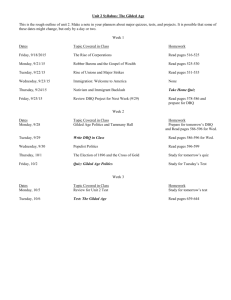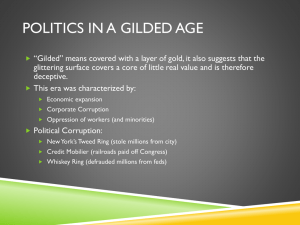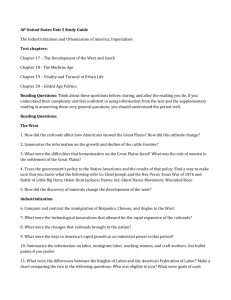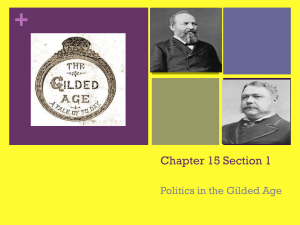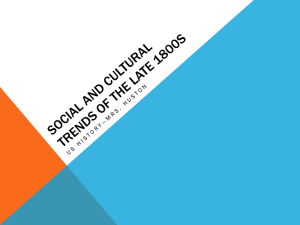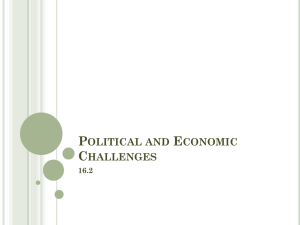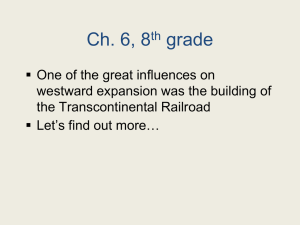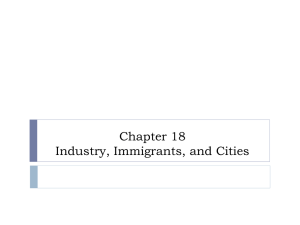AP 37 1877 to 1910
advertisement
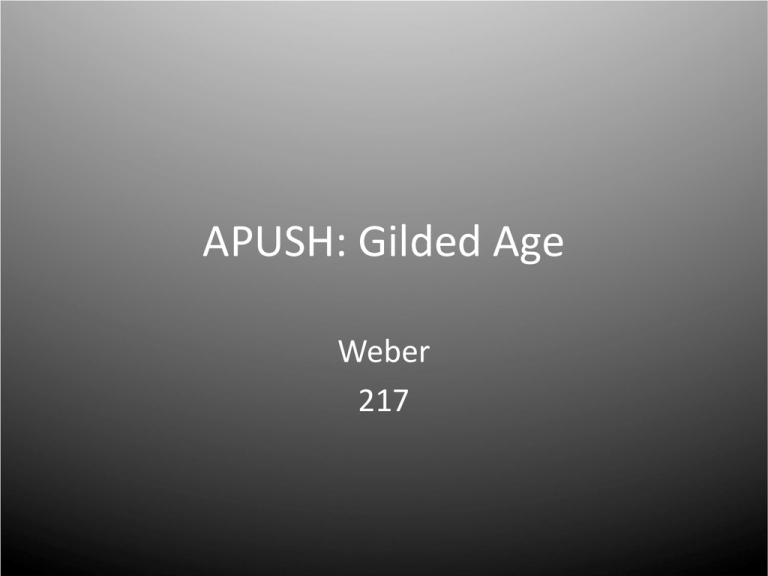
APUSH: Gilded Age Weber 217 Activator • About how much time have you spent reading chapter 16? About how many pages have you read? • What does “gilded” mean? • What are you most interested in finding out about during this period between 1877 and 1910? Agenda • • • • • • Activator, agenda, and objective (10 minutes) The “Gilded Age” notes (30-45 minutes) Comprehension check (15 minutes) Robber barons or captains of industry? Reading (time permitting) Exit ticket and homework (5 minutes) Unit 4: Toward a Global Presence • AP Topic #15. Industrial America in the Late Nineteenth Century – Corporate consolidation of industry – Effects of technological development on the worker and workplace – Labor and unions – National politics and influence of corporate power – Migration and immigration: the changing face of the nation – Proponents and opponents of the new order, e.g., Social Darwinism and Social Gospel The Second Industrial Revolution • By 1913 the US produced 1/3 of the world’s industrial output. • The 1880 census showed that for the first time the majority of people were engaged in nonfarming jobs. • Growth of cities was vital for financing industrialization. – Great Lakes region – Pittsburgh – Chicago Railroads and the National Market • The railroad made possible what is sometimes called the 2nd industrial revolution. • Growing population formed an everexpanding market for mass production, mass distribution, and mass marketing of goods. • New Inventions also spurred growth – Scientific breakthroughs poured forth from Thomas Edison’s lightbulb. Competition and Consolidation • Depression plagued the economy between 1873 and 1897 • Businesses engaged in ruthless competition • To avoid competition, corporations battled to control entire industries • Rise of Andrew Carnegie and John D. Rockefeller – Robber Barons vs. Captains of Industry Andrew Carnegie: “On Wealth” - The Anglo Saxon race is superior according to him. - “Gospel of Wealth” (1901) - Inequality is inevitable and good. - Wealthy should act as trustees for poor people. Rise of Big Business • Key Term: LAISSEZ FAIRE – the ideology of the industrial age. • Individual as moral and economic ideal. • Individuals should compete freely in the marketplace. • No room for the government in the market. • Private enterprise can do things better than government. New Types of Businesses and Elites • TRUSTS: • Horizontal integration: method of industrial control by which you buy up competitors factories in order to form one large one. – – John D. Rockefeller: Standard Oil Co. • Vertical consolidation: a method of industrial control in which a company buys up all the different aspects involved in that business. – Andrew Carnegie: Carnegie Steel bought the coke fields, iron ore deposits, steel mills, ships, and railroads. • CARTELS: • Loose association of business that make the same produce. Agree to limit the supply to keep prices high. New Types of Business Elites Corporate Mergers Percent of Billionaires (1900) Percent Billionaires (1918) Worker’s Freedom in an Industrial Age • For a minority of workers the rapidly expanding industrial system created new forms of freedom. • For most workers economic insecurity remained a basic fact of life • Between 1880 and 1900 an average of 35,000 workers perished each year in factory and mine accidents, the highest rate in the world! Politics in the “Gilded Age” • The corruption of politics • Urban politics fell under the sway of corrupt political machines – Boss Tweed controlled NYC politics with Tammany Hall for over 50 years • Corruption was at the national level too – Credit Mobilier scandal The Politics of Dead Center • Every Republican party candidate during this period had fought in the Union army. • Democrats dominated the South and Catholic votes • National elections were very close • Gilded Age politicians made little effort to mobilize public opinion or exert executive leadership Government in the Economy • The national political structure was not well prepared to deal with the problems created by the economy’s rapid growth • Tariff policy was debated • Return to the Gold Standard in 1879 • Republican economic policies seemed to favor the interests of eastern industrialists and bankers • The government made attempts at regulation – Interstate Commerce Commission (ICC) in 1887 – Sherman Antitrust Act Freedom in the Gilded Age • As the US matured into an industrial economy Americans struggled to make sense of the new social order • Many sensed that something had gone wrong or that the forces of the capitalist economy were out of their control • Many Americans were socialized to accept the concentration of wealth as inevitable, even natural, and justified by “progress” Freedom, Inequality, and Democracy • Gilded Age reformers feared that with lower-class groups seeking to use government to advance their own interests, democracy was becoming a threat to individual liberty and the rights of private property. • Many working class folks saw the wealthy elite as the threat to their freedoms and more socialist leaning union organizers critiqued capitalism’s effect on the relations between employer and employed – Antagonisms between the classes in the Marxist sense Social Darwinism • Charles Darwin put forth the theory of evolution whereby plant and animal species best suited to their environment took the place of those less able to adapt • Social Darwinism argued that evolution was a natural process and government must not interfere • This led to the belief that the individual should be free to struggle, succeed, or fail • Failure to advance in society according to this logic, then, was thought to indicate lack of character or ability • Social Darwinist William Sumner believed that freedom required the acceptance of inequality • This ideology had racist underpinnings and supported other theories about the hierarchy of human species. Liberty of Contract • With the rise of factory and wage labor came conflicts between boss and worker • As legal documents, labor contracts were meant to reconcile freedom and authority in the workplace • Demands by workers that government help struck liberals as an example of how the misuse of political power posed a threat to liberty Comprehension Check: write independently then pair share • 1. Why is this period called the “Gilded Age?” • 2. What did this period look like from the perspective of a wealthy industrialist or banker? • 3. What might it have looked like from the perspective of a factory worker? • 4. What would you say are the most important tensions/issues/problems in the new social order? John D. Rockefeller: Robber Barron or Captain of Industry? • Robber Barron: A pejorative (not nice) term for a businessman who dominated his industry by using unfair business practices and made a huge personal fortune. • Captain of Industry: A term used to describe a business man who got to the top because he was the best at what he did. Also refers to his leadership in giving back to the community through philanthropy (giving money for libraries, schools, etc.). Reading • As you read make a list of things you will need to know for the reading test or for the AP exam. • Use the AP topic as well as the chapter structure to assist you. • Put things in your own words. Exit ticket and homework • For Thursday • Finish reading ch.16 for the reading test. • Research one of the following and bring in evidence of your findings: – 1877 Great Railroad Strike – Knights of Labor – 1886 Haymarket Affair LABOR AND THE REPUBLIC Voices of A People’s History DBQ • In pairs, read one of the following documents, taking notes and answering the questions. Prepare to be able to teach the main ideas to your classmates. – – – – – – – – – – 1. Henry George 2. August Spies 3. “Red Handed Murder” 4. Reverend Ernest Lyon 5. Mary Elizabeth Lease 6. The Omaha Platform 7. Reverend Moore 8. Ida B Wells-Barnett 9. Statement of Pullman Strikers 10. Edward Bellamy Strikers and Populists DBQ • After getting the main points from each primary source, plan your DBQ essay on the following prompt: – To what extent is the following statement an accurate description of the period 1870-1910: “Working class people – Black and White, rural and urban – suffered at the hands of corporate industrial and agricultural interests during the Gilded Age.” – OR – To what extent is the following statement an accurate description of the period 1870-1910: “By the late 19th century, many working class Americans believed that instead of protecting their life and liberty, government deliberately sought to deprive them of their rights in order to protect the vested interests of the wealthy.” How did people react to Industrialization? Industrial workers – labor unions – strikes. Knights of Labor, AFL, Wobblies, Railroad strike of 1877, Homestead 1892, Pullman 1894 Farmers – Farmers Alliance – populism. Money supply, nationalize transportation, tax rich more Government – regulation – social programs. Regulating the railroads. Triangle Shirtwaist fire. Municipal reforms. Antitrust law Knights of Labor • An injury to one is the concern of all. • 8 hour work day. • Worker-owned factories. • No child labor. • Equal pay for men and women Child Labor American Federation of Labor (AF of L) 1886 • • • • • Mostly for skilled workers. Represented them in political matters. Maintained a national strike fund. Mediated disputes between labor and management through collective bargaining. Prevented disputes among many craft unions. • Samuel Gompers International Workers of the World (IWW) or Wobblies 1905 Opposed AFL. Socialist leadership. Violent strikes especially in WWI. The Great Railroad Strike 1877 – Started when wages were cut 10% during depression. – Strikers, sympathizers, rioters broke railroad property and clashed with local militias. – Federal troops called out – fired on crown in Pittsburg. – 20,000 angry people reacted by destroying $5 million in railroad property. – President Rutherford Hayes again called in troops. – Employers relied on state and federal armies to repress labor unrest. Haymarket 1886 • National demonstration for the 8 hour work day. • Police broke up a fight between strikers and “scabs” at McCormick reaper factory in Chicago killing many workers. • Protesters came to Haymarket Square where they were joined by anarchists (radicals who opposed government). • Riot with many dead on both sides. Four anarchists were tried for conspiracy to commit murder and hung. • Press blamed the AF of L. Pullman Strike 1894 • Pullman created a town for workers making luxury train cars. Built parks, etc. but also regulated behavior like banning alcohol etc. • Financial panic of 1893 – Pullman laid off workers and cut wages by 25% while keeping food prices in his town at the same level. • 260,000 workers joined the strike. • Because it blacked the delivery of mail, U.S. troops were called in. • The government cited the Sherman Antitrust law saying that the union was a trust and restrained free trade. • Set a pattern of government opposition to unions.
